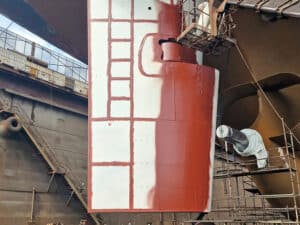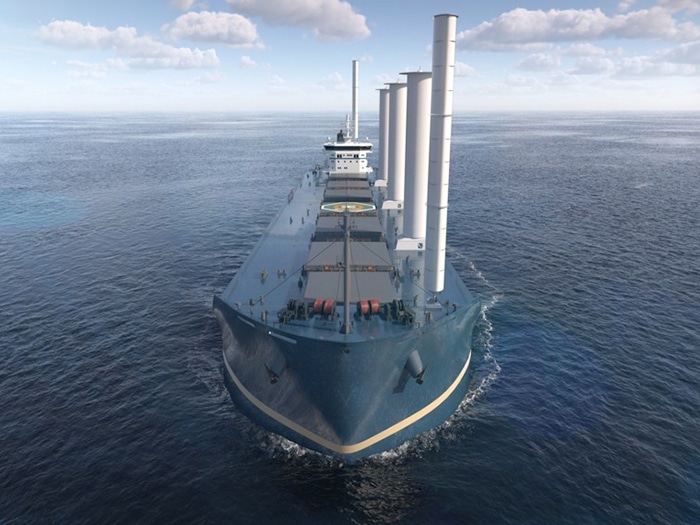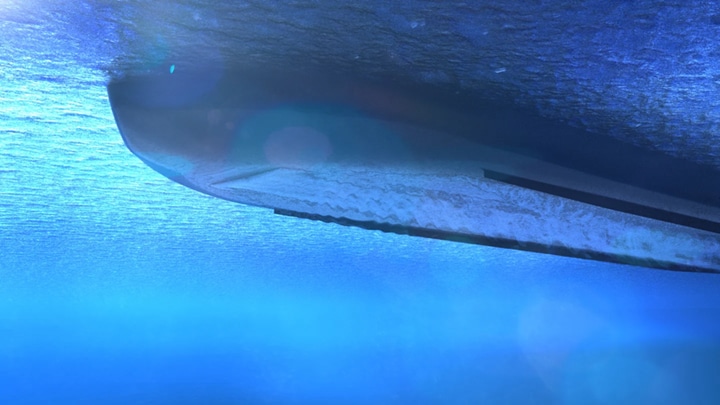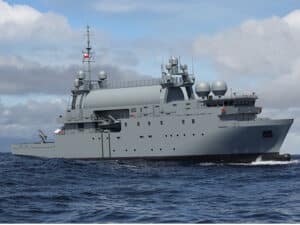
Kongsberg unveils design for new “Super-Efficient Bulker”
Written by Nick Blenkey
Super-efficient bulker concept combines two different wind assist technologies: three tiltable rotor sails and two suction wing sails.[Image: Kongsberg Maritime]
Can ship owners meet stringent future compliance targets without abandoning conventional fuels? Kongsberg Maritime has unveiled a new “Super-Efficient Bulker” vessel design concept intended to enable owners to do just that.
Developed together with Deltamarin, the design, says Kongsberg, demonstrates that compliance with future regulations is achievable even when using conventional fuels and promises fuel cost savings between 40-50% depending on the operational profile.
“While low-carbon fuels are an option, many prefer to stick with conventional fuels,” says Oskar Levander, vice president of strategy and business development at Kongsberg Maritime. “Our goal was to design a vessel capable of complying with predicted CII regulations throughout its lifetime, using advanced energy-saving technologies”
The vessel’s system integrates a hybrid shaft generator with frequency control, optimizing electrical power usage and reducing emissions, while supporting increased loads from wind-assist technologies and air lubrication compressors, enhancing overall efficiency.
Kongsberg Maritime selected a Kamsarmax bulker of 82,000 DWT, a common vessel size globally, as the basis for the new design. It says that this vessel type often faces restrictions with the global availability of low-carbon fuels, making it an ideal candidate for the study.
Collaborating with ship designer Deltamarin, Kongsberg Maritime explored various technologies to enhance the efficiency of the Kamsarmax. The result is the ‘Super-Efficient Bulker’, which incorporates several groundbreaking features.
The new vessel concept is based on a combination of three tiltable rotor sails and two suction wing sails. This dual approach maximizes wind power utilization, adapting to varying wind conditions to ensure optimal performance.
“This hybrid wind technology approach offers the best of both worlds, making the vessel more versatile and efficient,” says Henrik Sjöblom, a member of Kongsberg Maritime’s concepts and advisory team.

Kongsberg Maritime has devised an innovative hull form that will trap bubbles, from an air lubrication system, to maximize the effects of resistance reduction and has filed a patent application for concept. By trapping air bubbles beneath the hull, the system significantly reduces frictional resistance. The inclined hull, with a 1-degree slope from bow to stern, and vertically turned bilge keels create “walls” to keep bubbles in place, enhancing fuel savings.
To maintain the hull’s cleanliness and further minimize resistance, the vessel is also fitted with a Hull Skater, which also contributes to maintaining low fuel consumption during operation.
Emphasizing the benefits of slow steaming, the vessel operates at a reduced speed, balancing fuel efficiency with operational viability. A one-knot speed reduction contributes to substantial savings in fuel, emissions, and maintenance costs.
The hybrid shaft generator with frequency control optimizes electrical power usage, reducing emissions. The system supports the increased electric load from wind propulsion devices and air lubrication compressors, enhancing overall efficiency. Equipped with an intelligent energy management system (iEMS) and route optimization software, the vessel ensures optimal energy use, further enhancing fuel efficiency and reducing operational costs.
“With a short payback period of five years, this vessel represents a smart investment for ship owners looking to reduce costs and meet future compliance targets,” says Oskar Levander.
According to Kongsberg Maritime’s analysis, in operation. the “Super-Efficient Bulker“ will reduce fuel costs by more than half compared to a state-of-the-art vessel equipped with only conventional technology.
The concept combines two different wind assist technologies, three tiltable rotor sails and two suction wing sails, which maximizes wind power by adapting to varying wind conditions for optimal performance.
Oskar Levander concludes, “This project has been a real eye-opener. The combination of advanced technologies creates significant savings, making our new design a game-changer. With a short payback period of five years, this vessel represents a smart investment for ship owners looking to reduce costs and meet future compliance targets. At Kongsberg, we are committed to integrating the best technologies to drive the maritime industry towards a cleaner, more efficient future.”





